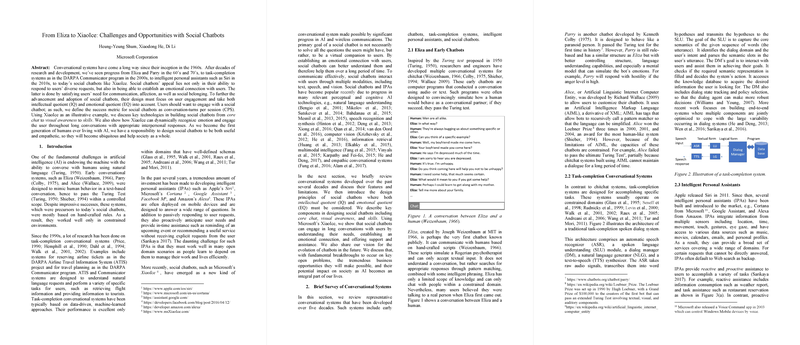From Eliza to XiaoIce: Challenges and Opportunities with Social Chatbots
The paper, authored by Heung-Yeung Shum, Xiaodong He, and Di Li from Microsoft Corporation, provides a comprehensive analysis of the evolution of conversational systems, focusing on the paradigm shift from basic chatbots to sophisticated social chatbots like Microsoft’s XiaoIce.
Conversational systems have experienced significant advancements since the 1960s. Beginning with rudimentary programs like Eliza and Parry, which relied on rule-based approaches for text-based interactions, the paper traces enhancements leading up to intelligent personal assistants (IPAs) such as Siri and ultimately to present-day social chatbots like XiaoIce.
Evolution of Chatbots
The paper highlights the transition from early chatbots that aimed to pass the Turing Test through mimicry of human conversation to IPAs designed for task completion. IPAs, including Siri and Cortana, incorporate proactive assistance based on user preferences and context, though they still operate within semi-constrained environments.
The paper particularly emphasizes social chatbots, which differ from task-focused systems by fostering emotional connections with users. The success of these systems is evaluated through Conversation-Turns per Session (CPS), a metric highlighting engagement effectiveness.
Design Principles of Social Chatbots
Social chatbots are crafted to satisfy users' needs for communication and emotional connection. The integration of intellectual quotient (IQ) and emotional quotient (EQ) is fundamental for these systems. Key capabilities include:
- Empathy: Detecting and responding to users' emotions and sentiments.
- Interpersonal Skills: Personalizing interactions based on user profiling and context.
- Personality Consistency: Maintaining a steady personality to build trust and engagement.
The framework for these chatbots includes a multimodal interface capable of interpreting text, speech, and images, reflecting the need for advanced semantic understanding and response generation technologies.
Technological Framework
The architecture of a social chatbot comprises several critical components:
- Core Chat: Responsible for semantic encoding and generating contextually relevant responses through advanced neural models such as LSTMs.
- Visual Awareness: Enables understanding and commenting on images, using deep learning models for image-caption alignment and sentiment analysis.
- Skills Integration: Allows the chatbots to perform diverse tasks, enhancing their utility and user satisfaction.
XiaoIce as a Case Study
XiaoIce serves as a case paper demonstrating these principles in action. With over 100 million users globally, XiaoIce boasts a high CPS, indicative of its engaging design. Its capabilities extend beyond text-based conversation to image commenting, poem writing, and even singing with human-like expressiveness.
Experimental results reveal substantial CPS improvements, underscoring XiaoIce's increasing sophistication. Additionally, user feedback indicates that interactions with XiaoIce often lead to enhanced mood and emotional well-being, highlighting its practical benefit.
Future Directions and Considerations
The paper identifies several open areas requiring breakthroughs for more advanced AI chatbot development, including empathic conversation modeling, neural-symbolic reasoning, and memory modeling.
The authors also urge adherence to ethical standards in chatbot design to prevent harm and promote positive societal impact. As social chatbots gain prevalence, the importance of ethical considerations in deployment becomes paramount.
In summary, this paper articulates the challenges and innovations in conversational systems, with a focus on social chatbots' role in providing emotionally intelligent, engaging, and practical AI companions. The evolution from Eliza to XiaoIce illustrates significant progress while highlighting the complex challenges ahead in refining AI's interaction capabilities.
